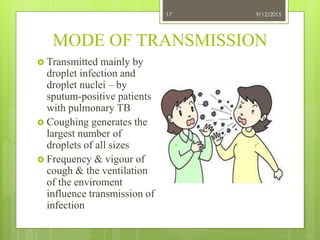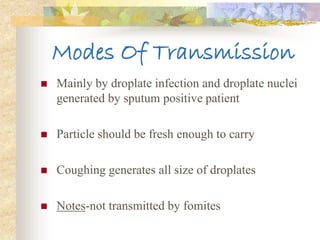Explain Different Modes of Transmission of Tb Infection
With TB however the mode of transmission is the cough or sneeze that releases TB bacterium into the air. Mode of transmission of TB.

Mode Of Transmission Of Tuberculosis Download Table
Hantavirus is found in mouse feces urine and saliva but when these substances dry they can disintegrate into fine particles that can become.

. Direct inoculation can occur from bites or scratches. Viral gastroenteritis Clostridium difficile MRSA scabies. Hosts refer to the susceptible population.
Disease transmission depends indirectly on droplet size. Thus the probability of disease transmission depends on the pathogen load of the droplet and on its deposition location in the respiratory tract. Modes of Direct Transmission infective form of agent transferred directly from reservoir or host.
Direct Transmission This occurs. 11 rows There are two different modes of transmission of diseases. Dust and fine particles known as aerosols which can float in the air can carry pathogens and facilitate the airborne transmission of disease.
D failure of the patient to cover the mouth and nose when coughing or sneezing. Hantavirus is found in mouse feces urine and saliva but when these substances dry they can disintegrate into fine particles that can become. Than one mode of transmission eg.
It can then be inhaled by another person in the room. Sharing food or drink. Direct exposure to an infectious agent in the environment 4.
Direct contact transmission occurs through direct body contact with the tissues or fluids of an infected individual. Tuberculosis infections aerosolized dropletes. This may be of three types i Propagative.
People nearby may breathe in these bacteria and become infected. TBPs should be tailored to the particular infectious agent involved and the mode of transmission. Airborne droplets transmit the pathogen from ambient air to the respiratory tract through inhalation and deposition.
The Different Modes of Transmission Direct Contact. Tuberculosis is a contagious airborne disease which can be acquired from close contact with an infected person. Many bacterium are transported by unwashed hands that transmit the bacterium to other surfaces.
Direct contact takes place through skin-to-skin contact as well as kissing and sexual intercourse. Infectious droplet nuclei are generated when persons who have pulmonary or laryngeal TB disease cough sneeze shout or sing. The mode of transportation is how the bacterium moves from one place to another.
The TB bacteria are put into the air when a person with TB disease of the lungs or throat coughs speaks or sings. For more details about the mode of transmission of communicable diseases. E presence of cavitation on chest radiograph.
Diseases can spread through either direct or indirect contact. Transmission of Infectious Diseases. Vectors transmit disease in two ways a Mechanical Transmission.
Persons with pulmonary tuberculosis PTB when they cough sneeze or speak dropletes containing bacteria are released and people nearby who get infected. Dust and fine particles known as aerosols which can float in the air can carry pathogens and facilitate the airborne transmission of disease. This may be by direct contact such as touching kissing or sexual intercourse or by the direct spread of droplets by sneezing or coughing.
Some people are more prone to infection and become hosts. Hantavirus is found in mouse feces urine and saliva but when these substances dry they can disintegrate into fine particles that can become. B presence of cough or other forceful expiratory measures.
Direct contact transmission occurs when there is physical contact between an infected person and a susceptible person. In this section well explore the specifics of these contact occurrences. Chickenpox can be transmitted by airborne droplet or contact transmission.
F inappropriate or short. Contact transmission direct or indirect eg. Metabolic diseases such as diabetes can also increase the risk of contracting TB.
For example dust particles are the dominant mode of transmission of hantavirus to humans. Characteristics of the TB patient that enhance transmission include a disease in the lungs airways or larynx. Infectious Disease Transmission Through Direct Contact.
The first way that infection can spread is through direct contact. Mycobacterium Tuberculosis is one of the leading causes of this dreadful infectious disease. Is carried in airborne particles called droplet nuclei of 1 5 microns in diameter.
For example dust particles are the dominant mode of transmission of hantavirus to humans. TB bacteria are spread through the air from one person to another. For example dust particles are the dominant mode of transmission of hantavirus to humans.
Physical transfer and entry of microorganisms occurs through mucous membranes eg eyes mouth open wounds or abraded skin. Modes of Transmission of Infectious Diseases. Pulmonary tuberculosis chickenpox measles.
Mode of transmission is the way the infectious agent can be passed on through direct or indirect contact ingestion or inhalation Portal of entry is the way the infectious agent can enter a new host through broken skin the respiratory tract mucous membranes and catheters and tubes. C presence of acid-fast bacilli AFB in the sputum. Influenza pertussis whooping cough rubella.
Depending on the environment these tiny particles can remain suspended in the air for several hours. Touching bed linens or toilet seats. A single cough can produce 3000-5000 tiny droplet nuclei.
Blood transfusions and transplacental infection from mother to fetus are other important means of direct transmission. Direct spread of droplets 3. TB is NOT spread by.
Indirect contact transmission occurs when there is no direct human-to-human. Please refer to. Diarrhea dysentery and typhoid fever by the housefly and b Biological Transmission.
There are two types of contact transmission. The disease agent is carried mechanically on the legs or body of the insect eg. Contact transmission is the most common form of transmitting diseases and virus.
Dust and fine particles known as aerosols which can float in the air can carry pathogens and facilitate the airborne transmission of disease.

Mode Of Transmission Of Tuberculosis Download Scientific Diagram

Epidemiology Prevention Of Tuberculosis

Mode Of Transmission Of Tuberculosis Download Scientific Diagram

Mode Of Transmission Of Tuberculosis Download Scientific Diagram

References In The Transmission Of Mycobacterium Tuberculosis In High Burden Settings The Lancet Infectious Diseases

Pdf What We Know About Tuberculosis Transmission An Overview

Tuberculosis Transmission Routes And Unexpected Sources Of Infection Otsuka Pharmaceutical Co Ltd

Mode Of Transmission Of Tuberculosis Download Scientific Diagram

Belum ada Komentar untuk "Explain Different Modes of Transmission of Tb Infection"
Posting Komentar